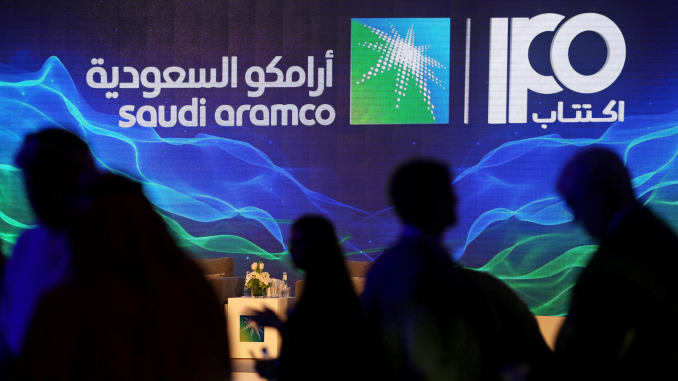
When shares of Saudi Arabia’s national oil company begin trading Wednesday after the world’s largest initial public offering, the stars will be aligned to ensure that the stock price holds up.
Aramco sold $25.6 billion of shares at 32 riyals each, the top of the range at which they were marketed, and the company had orders for $119 billion of stock. About 4.9 million individual investors, almost 15% of the kingdom’s population, applied for the shares. Saudi Arabia sold only 1.5% of the company’s capital in the IPO.
That unsatisfied demand alone should ensure a strong first day of trading. But Saudi Crown Prince Mohammed bin Salman isn’t leaving anything to chance. From bonus shares to a fat dividend, there’s a lot to underpin the price, at least initially. His half-brother, Energy Minister Prince Abdulaziz bin Salman, predicted Friday that Aramco’s value will soon surge, just after the kingdom announced production cuts that were taken as supportive for oil prices.
“I see further upside to the stock after listing due to the fact that investors will be chasing the stock to complete their exposure, since the deal was oversubscribed,” said Ali El Adou, head of asset management at Daman Investiments in Dubai. Aramco shares also will be supported by the company’s dividend plans and strong balance sheet, he said.
For now, at least, the IPO also has the benefit of an increase in the broader market. The main equity index in Riyadh was up 0.9% at 12:45 p.m. local time, extending gains this week to 3.4%.
Individual investors in Saudi Arabia were heavily targeted by a country-wide marketing campaign prior to the IPO. Retail investors who hold the shares for 180 days from the first day of trading will be eligible to receive one share for every 10 held. The maximum bonus shares will be 100 per investor.
To boost demand, authorities allowed lenders to provide credit for stock purchases at a proportion that was twice the usual for IPOs. That might have helped inflate demand for the offering. Of course, if the stock falls in the short term, that could result in mark-to-market losses on margin loans for the banks, said Edmond Christou, who follows banks for Bloomberg Intelligence in Dubai.
Aramco’s board said the company will pay at least $75 billion of ordinary dividends in 2020, in addition to any potential special payouts. Investors were given the guarantee that the dividend won’t fall until after 2024, regardless of what happens to oil prices. Dividend sustainability is supported by stable cash flows and the company’s relatively small planned increase in capital spending, amid other factors, analysts at KAMCO Investment Co. wrote in a note on Dec. 4.
Traders, investors and analysts in the past have speculated that funds tied to the Saudi government have stepped in to prop up the stock market, especially at moments of increased geopolitical volatility. In a poll of 24 money managers last month, 22 said they expect Aramco shares to be supported by government-related funds once they start trading.
The Public Investment Fund, Saudi Arabia’s sovereign wealth fund, didn’t respond to a request for comment on whether it will buy Aramco shares in the secondary market.
Aramco is so big that index compilers will speed up its inclusion in global benchmarks. MSCI Inc., which provides the most popular emerging-markets equity index, said last month that Aramco will be added by the close of Dec. 17 if it starts trading on or before Dec. 12. The inclusion by MSCI should trigger about $2.4 billion in flows into the stock, according to estimates by Saudi Fransi Capital. FTSE Russell also has said it’s studying the potential fast-track inclusion of the stock in its benchmarks.
Bloomberg News
Метки: IPO Aramco, Saudi Aramco
















